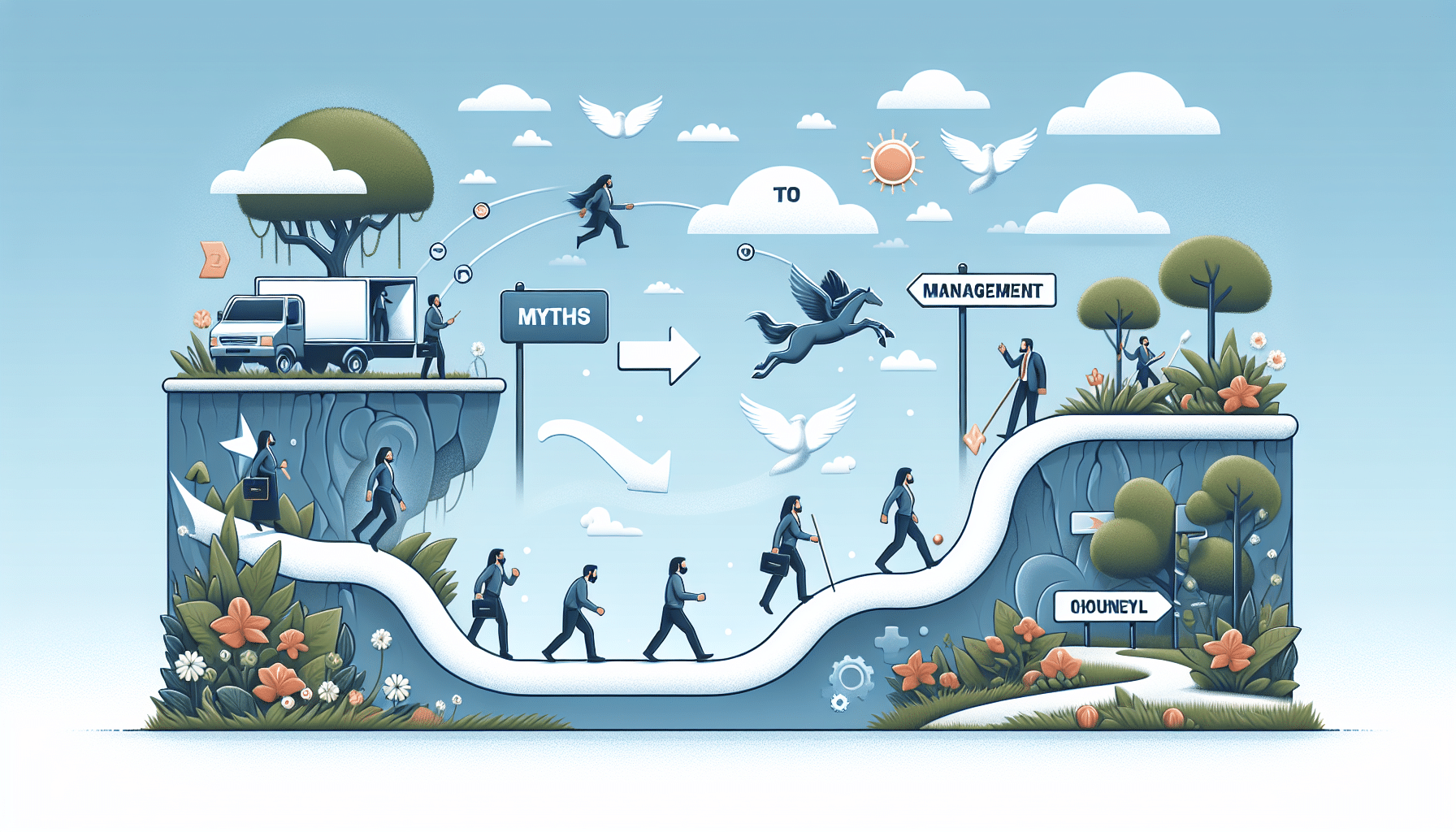Your basket is currently empty!
Leadership Myths Exposed: A Powerful Guide for New Managers
In This Article
- Leadership myths are persistent but unfounded beliefs that undermine effective leadership.
- New leaders often fall into traps such as needing to appear perfect or controlling every outcome.
- Influence comes from trust and credibility, not job titles.
- Authenticity and vulnerability strengthen leadership impact.
- Leaders are made through learning, reflection, and experience—not born.
- Mentorship and ongoing feedback are crucial developmental tools.
- Modern frameworks offer research-backed alternatives to outdated leadership models.
- Putting learning into practice helps dispel myths and build leadership confidence.
Understanding Leadership Myths
What They Are and Why They Persist
Leadership myths are persistent false beliefs or outdated assumptions about what it means to be a “leader”. These misconceptions often arise from anecdotal experience, popular culture, or outdated models of leadership. Despite lacking empirical support, they continue to influence how people view authority, effectiveness, and success in leadership roles. One of the major reasons these myths hold such sway is that they are often simple, emotionally appealing, and confirm deeply held biases about power and personality.
For example, the idea that “leaders are born” appeals to the romantic notion of the natural-born genius. However, this view disregards decades of research on learned behaviours, emotional intelligence, and leadership development. Likewise, the myth that leaders must never show weakness fosters a culture of fear and perfectionism, stunting innovation and honest communication. These leadership myths can shape decision-making processes, hiring practices, and even the self-perceptions of emerging leaders who feel they don’t “fit the mould”.
If left unchallenged, such myths can damage team morale, weaken leadership pipelines, and hinder the growth of otherwise capable professionals. That’s why a critical examination of leadership myths isn’t just beneficial—it’s imperative for building effective, empathetic, and resilient leaders.

Why Myths Matter for New Leaders
Common Pitfalls and Misconceptions
New leaders often enter their roles with a mix of excitement and trepidation. Unfortunately, many fall into traps laid by pervasive leadership myths. For instance, believing one must have all the answers can lead to micromanagement, burnout, and alienation from one’s team. Likewise, assuming leadership requires assertive dominance may result in poor communication, low trust, and resistance from colleagues.
These myths can have tangible impacts on a leader’s performance and credibility. One common pitfall is overcompensation—leaders acting inauthentically as they try to model themselves after an imagined ideal. Instead of focusing on their strengths and personality-fit, they fake confidence, avoid showing vulnerability, and misinterpret healthy team dynamics as signs of disrespect or insubordination.
Other misconceptions include equating title with influence, or assuming empathy is a weakness. These myths strip leadership of its relational foundation and turn it into a top-down transaction rather than a collaborative journey.
“Leadership is not about being in charge. It is about taking care of those in your charge.” – Simon Sinek
Myth #1: Leaders Are Born, Not Made
This myth implies that leadership is an innate quality—something you either have or you don’t. However, abundant research in psychology and organisational behaviour proves otherwise. Leadership is a set of behaviours, skills, and mindsets that can be developed over time. While some individuals may possess natural charisma or confidence, effective leadership relies on continuous learning, self-awareness, and adaptability.
Discarding this myth opens up the leadership path to a much more diverse group of individuals. Programmes focused on leadership development, coaching, and on-the-job experiences prove that learning to lead is both possible and widely achievable.
Myth #2: Good Managers Have All the Answers
Many new leaders feel they must have solutions to every problem. This belief stems from the misconception that knowledge equals credibility. In truth, the best leaders are those who ask the right questions and facilitate solution-finding through collaboration.
Rather than projecting omniscience, admitting when you don’t have all the answers builds humility and trust. Modern leadership is about creating environments where teams feel empowered to ideate, experiment, and grow together. Recognising that knowledge is distributed and that learning never ends is key to strong, sustainable leadership.
Myth #3: Authority Equals Influence
Holding a title does not automatically grant influence. True influence is earned through trust, consistency, and authentic communication. Leaders who demand compliance based solely on their position risk disengagement and resistance from their team.
Conversely, those who cultivate genuine connections, listen actively, and act with integrity are more likely to positively influence outcomes. Influence, after all, is less about orders and more about inspiration. Breaking this leadership myth helps leaders lower resistance, foster collaboration, and enact meaningful change.
Myth #4: Leadership Requires Aggressiveness
Aggressiveness is often mistaken for assertiveness, and this confusion can be harmful. While assertiveness is about clear, respectful communication of boundaries and expectations, aggressiveness involves domineering, demanding behaviour that silences others.
This myth promotes power-hoarding and undercuts healthy team dynamics. Researchers have consistently shown that leaders who lead with empathy and emotional intelligence often outperform their more aggressive counterparts. The modern workplace values collaboration far more than intimidation. Leaders are better served by focusing on clarity, consistency, and compassion.
Myth #5: Mistakes Must Be Avoided at All Costs
The reality is that learning and innovation depend heavily on trial, error, and reflection. Embracing mistakes as learning opportunities, rather than failures, fosters psychological safety and cultivates a growth mindset. Leaders who pretend to be infallible inadvertently teach their teams that vulnerability is unacceptable.
Instead, acknowledging errors and sharing the lessons learned helps to humanise the leadership role. It sets a precedent that mistakes, when acknowledged and addressed, are catalysts for growth—both personal and organisational.
Evidence-Based Strategies for Growing as a Leader
Moving beyond leadership myths requires practical tools and conscious effort. New leaders should prioritise continuous learning through formal courses, coaching, and reflective practice. Engaging with trusted resources, including academic studies and success stories, reinforces growth-oriented behaviour.
Start by identifying your leadership values and aligning them with your actions. Leverage psychometric tools or leadership assessments to understand your style and potential blind spots. Adopt goal-setting frameworks such as SMART goals or OKRs to track development milestones. Additionally, peer learning and knowledge sharing within leadership circles amplify insight and resilience.
Building Your Authentic Leadership Style
Authenticity in leadership is not just a trend—it is a necessity. Trying to emulate someone else’s style often leads to awkwardness and disconnect. Instead, focus on nurturing your own strengths and being consistent in values and behaviours.
Authentic leaders are self-aware, transparent, and lead with purpose. They acknowledge not having all the answers and are comfortable soliciting input. To cultivate authenticity, regularly reflect on your leadership impact: What behaviours encourage engagement? Which habits disrupt trust or productivity? This kind of honest introspection helps dispel leadership myths and reinforces sustainable leadership practices.
The Role of Mentorship and Feedback
Mentorship is a powerful antidote to leadership myths. By connecting with experienced leaders, mentees gain nuanced perspectives that challenge stereotypes and build confidence. Mentors also model realistic growth, illustrating that leadership is more marathon than sprint. They share think-alouds, decision processes, and stories of setbacks that normalise vulnerability.
Feedback, when given constructively and received openly, reveals blind spots and propels improvement. Leaders should routinely seek upward feedback from direct reports, in addition to peer and superior feedback. This 360-degree approach enables holistic self-awareness—which directly counters myths such as needing to be invulnerable or all-knowing.
To find structured growth opportunities, consider joining a leadership programme or organisational network. These platforms encourage dialogue around leadership challenges and foster deeper learning. Learn more about Leadership and Management Essentials
Frameworks That Help Break Leadership Myths
Several frameworks provide practical tools to overcome common leadership myths. For instance, the Situational Leadership Theory teaches leaders to adjust their approach based on employee readiness. This flexibility disrupts the myth of “one-size-fits-all” leadership.
Another notable framework: Brené Brown’s research on vulnerability and courage in leadership. Her work dismantles the belief that leaders must be stoic and unaffected. Additionally, Adaptive Leadership highlights the need for leaders to address complex, evolving challenges rather than cling to rigid procedures.
Incorporating these frameworks empowers leaders to identify and discard unhelpful myths while replacing them with evidence-based strategies rooted in emotional intelligence and strategic awareness. Leadership Myths: Navigating the Complex Landscape
Putting It All Into Practice
Action is the final and most crucial step. Theories and awareness are vital, but they must translate into lived behaviours. Start small—introduce vulnerability in a team meeting, delegate decision-making intentionally, or engage in active listening exercises.
Track changes in team dynamics, personal growth, and performance indicators. Reflect regularly via journaling or coaching discussions. Refrain from perfectionism—leadership is about learning just as much as leading. The more you commit to conscious application, the sooner the myths will lose their influence over your style and identity.
Look within your organisation for Leadership Development Programs or informal support networks. Cross-functional projects and Read a related article are also excellent arenas for low-risk leadership experimentation.
Conclusion: Embrace Growth and Let Go of Myths
[CONCLUSION_CONTENT]
The landscape of leadership is constantly evolving, and clinging to leadership myths can severely limit personal and organisational development. By debunking these myths and adopting a mindset of curiosity, humility, and authenticity, new leaders position themselves for long-term success. Remember that leadership is not a fixed trait—it is a continuous journey of growth, reflection, and courage.
Great guide on from-myths-to-management-a-comprehensive-guide-for-new-leaders-interactive – Community Feedback
What are the most common myths about management?
Common myths include that leaders are born, not made, and that effective managers need to have all the answers. These misconceptions can hold new leaders back from developing their own authentic style.
How can new leaders overcome management misconceptions?
By seeking out evidence-based strategies, engaging in self-reflection, and leveraging mentorship or training, new leaders can identify and move beyond common myths.
What skills are essential for new managers?
Critical skills include communication, emotional intelligence, adaptability, and the ability to foster a collaborative environment.

